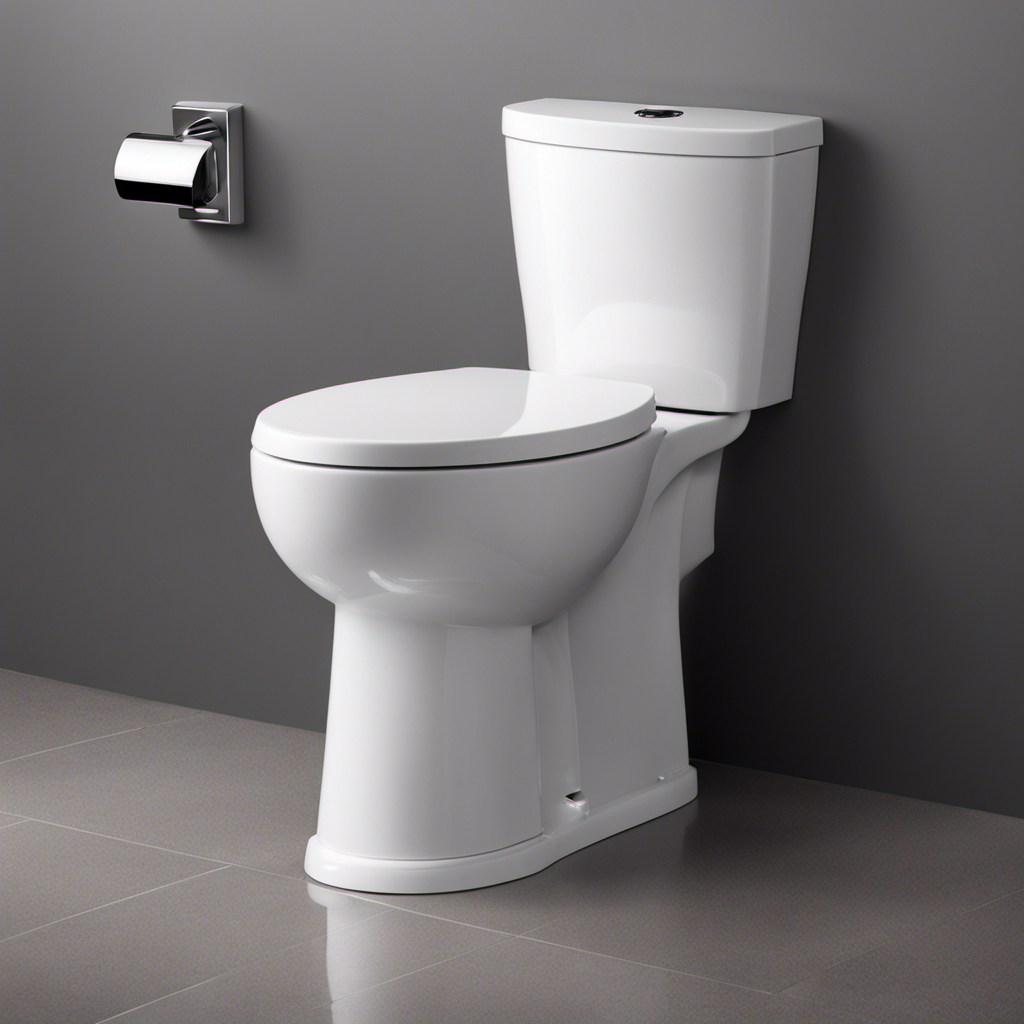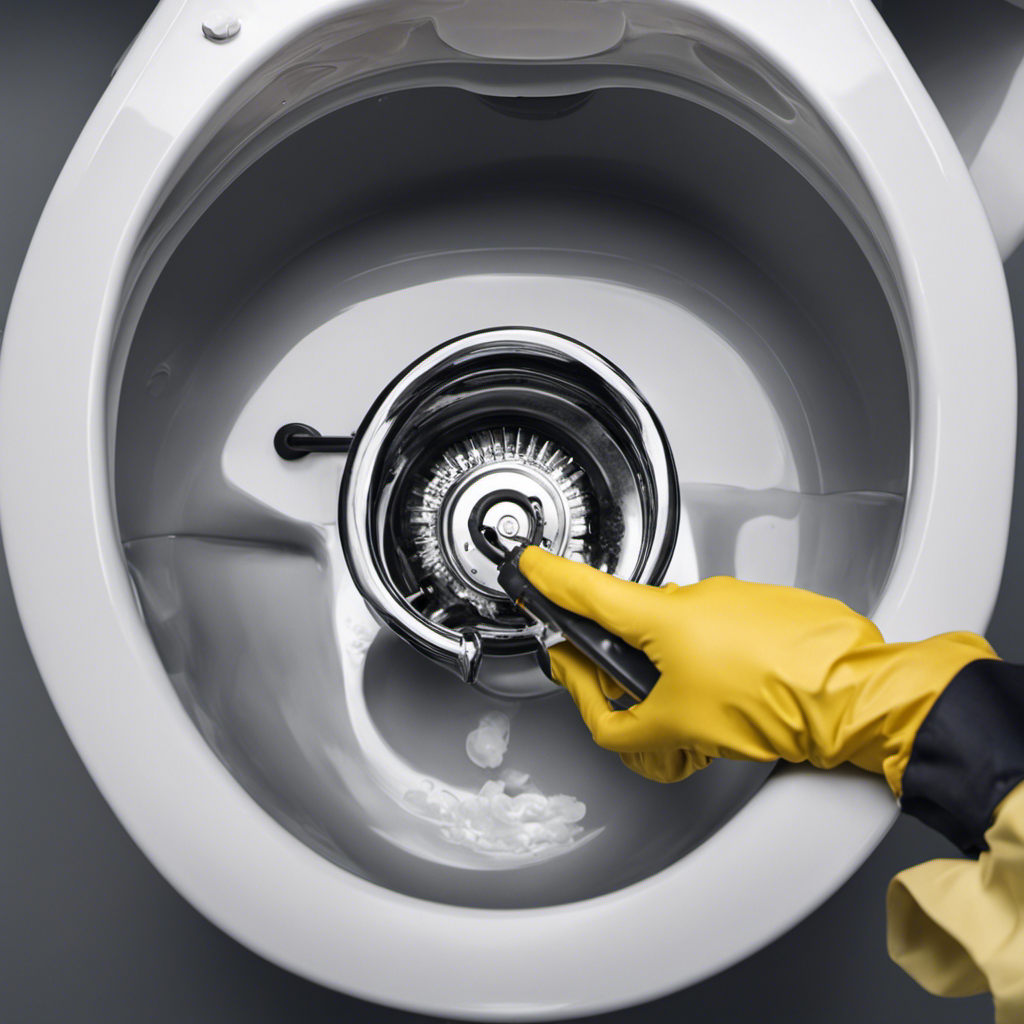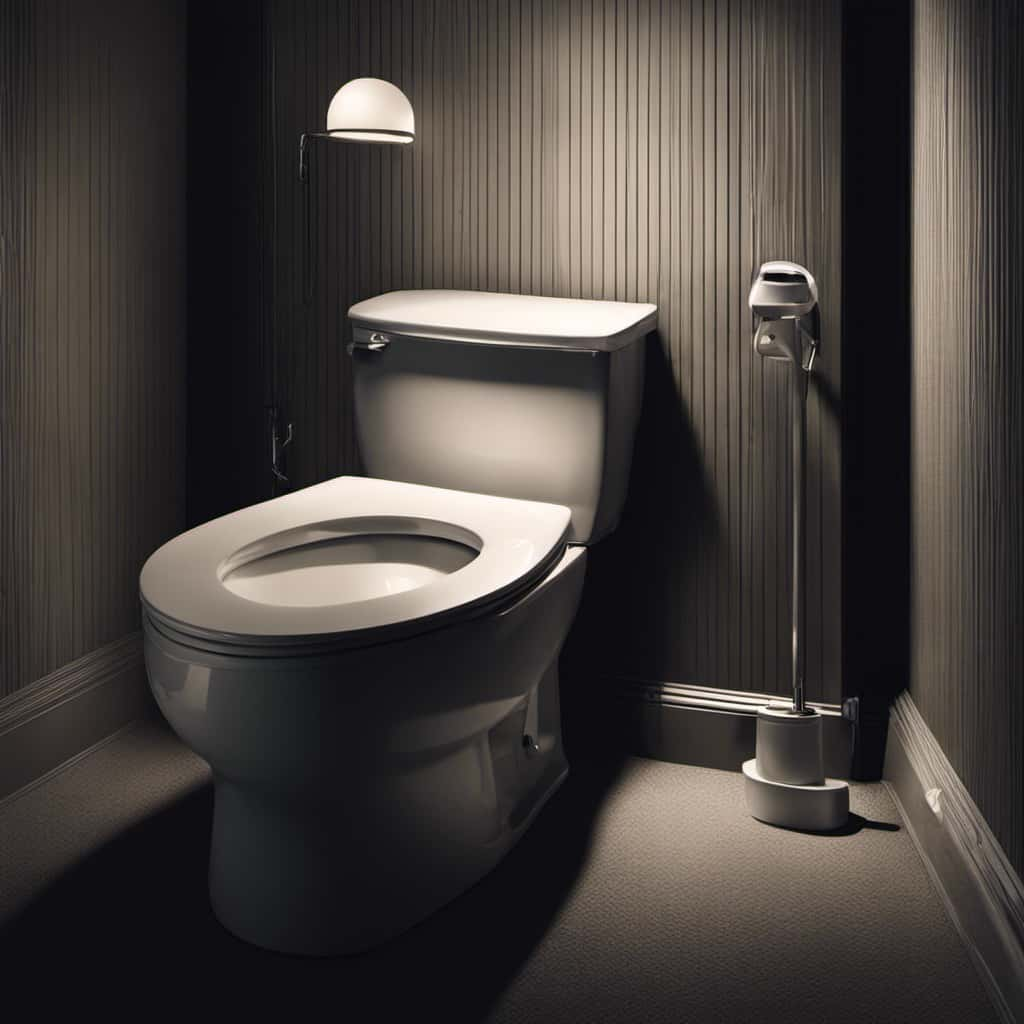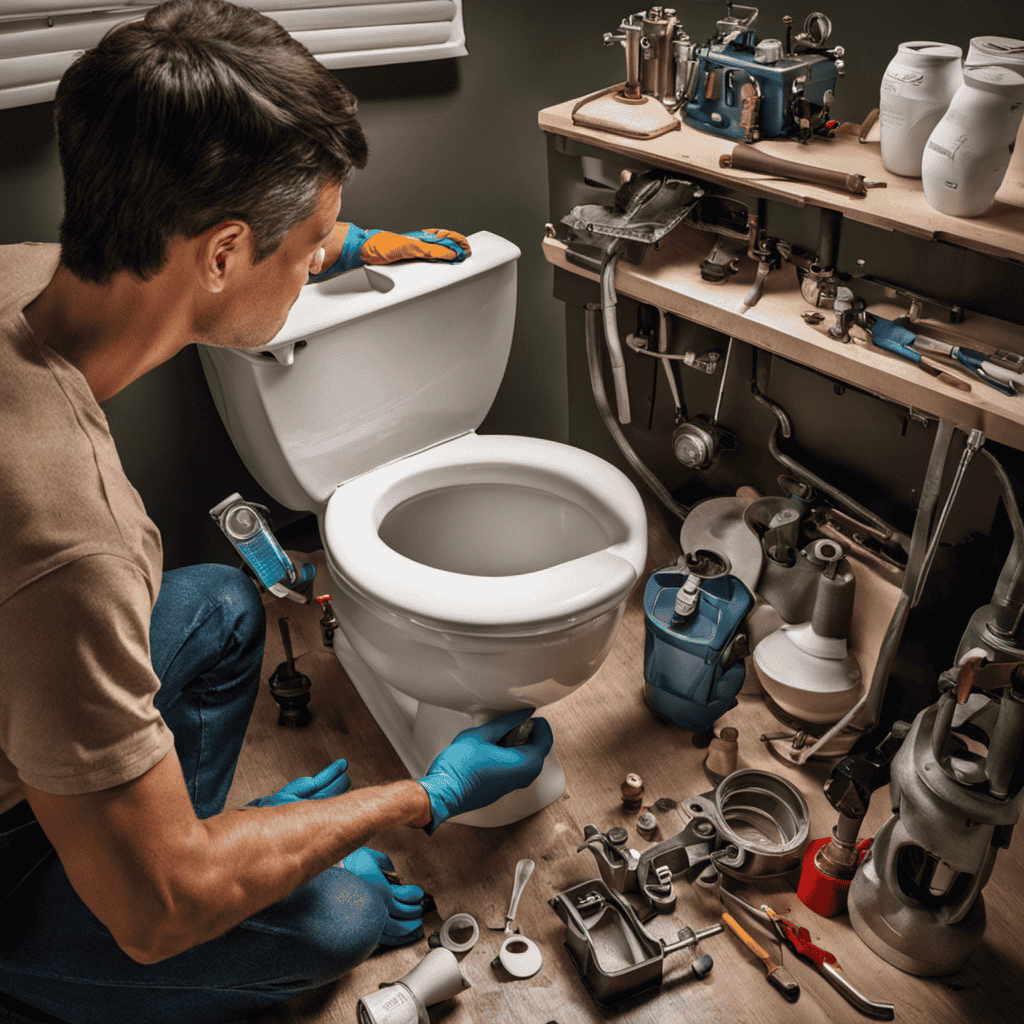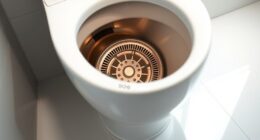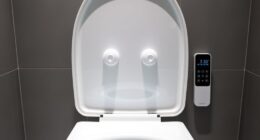So, you’ve had enough of your toilet’s lackluster flushing performance, huh? Well, fear not, my fellow bathroom aficionado, because I’m about to drop some serious knowledge bombs on how to make that porcelain throne flush like a champion.
From checking and adjusting the water level to clearing clogs and blockages, I’ve got all the technical know-how you need.
So grab your plunger and get ready to upgrade your flushing game, because we’re about to dive deep into the world of toilet mechanics.
Key Takeaways
- Regular maintenance is essential for proper flushing.
- Weak flushes can be caused by clogged rim or siphon jet holes, which can be troubleshooted with a wire hanger.
- Checking and adjusting the water level is important for efficient flushing, and can be done using the adjustment screw or valve.
- Upgrading to a dual-flush system can improve flushing performance and save water.
Understanding the Flushing Mechanism
To understand how to make your toilet flush better, it’s important to grasp the flushing mechanism. The flushing mechanism is composed of several key components that work together to ensure proper flushing. Regular maintenance of these components is essential to avoid any flushing problems.
One of the most common issues is a weak flush, which can be caused by a clogged rim or siphon jet holes. To troubleshoot this, you can use a wire hanger to clear any debris from these areas.
Another problem is when the toilet doesn’t flush at all, which could indicate a faulty flapper valve. In such cases, replacing the flapper valve can solve the issue.
Understanding the flushing mechanism and performing regular maintenance will help keep your toilet flushing efficiently.
Now, let’s move on to checking and adjusting the water level.
Checking and Adjusting Water Level
When it comes to maintaining a well-functioning toilet, it is crucial to ensure that the water level is set at the optimal height. This not only ensures efficient flushing but also prevents unnecessary water waste.
Adjusting the float height is a simple yet effective way to achieve the desired water level, and it can be easily done with the help of a screwdriver and some basic knowledge of the flushing mechanism.
Optimal Water Level
Check if the water level in your toilet tank is set at the optimal level for a better flush. To ensure a powerful and efficient flush, it is crucial to maintain the correct water level in the tank. Here are some key points to consider:
-
Adjusting the water level:
-
Locate the water level adjustment screw or valve on the fill valve assembly.
-
Turn the screw or valve clockwise to decrease the water level or counterclockwise to increase it.
-
Flush the toilet and observe the water level to see if it needs further adjustment.
-
Benefits of optimal water level:
-
Proper water level ensures enough water in the toilet bowl for effective waste removal.
-
It helps maintain consistent water pressure, resulting in a stronger flush.
-
Optimizing the water level reduces the chances of clogs and promotes better overall toilet performance.
Adjusting Float Height
Adjust the float height in your toilet tank to ensure optimal water level and prevent any potential issues.
When it comes to troubleshooting common flushing issues, adjusting the float position is often the first step. The float, which is typically a plastic ball or cylinder attached to an arm, controls the water level in the tank.
If the water level is too low, the toilet may not flush properly, resulting in weak or incomplete flushes. On the other hand, if the water level is too high, it can lead to constant running or even overflowing.
By adjusting the float height, you can fine-tune the water level to the desired level. To do this, simply locate the adjustment screw or clip on the float arm and move it up or down as needed.
Experiment with different float heights until you achieve optimal water level and a better flushing performance.
Ensuring Efficient Flushing
To ensure efficient flushing, it’s important to fine-tune the water level by adjusting the float height in your toilet tank. By doing so, you can optimize the flush power and save water at the same time.
Here are some techniques to achieve this:
-
Adjust the float height: By lowering the float, you decrease the water level, reducing the amount of water needed for each flush. This not only saves water but also improves the flushing power by creating a stronger force.
-
Install a dual-flush system: These systems offer two options for flushing, typically a full flush for solid waste and a half flush for liquid waste. This allows you to choose the appropriate amount of water needed for each flush, further maximizing water efficiency.
Clearing Clogs and Blockages
When it comes to clearing clogs and blockages, there are a few key methods to consider.
Plungers and alternatives, such as toilet augers, can be effective tools for dislodging stubborn clogs.
Chemical drain cleaners can also be used, but caution should be exercised as they can be harsh on pipes and harmful to the environment.
In more severe cases, it may be necessary to seek the assistance of professional plumbing services to thoroughly address the issue and prevent further damage.
Plungers and Alternatives
Using a plunger can quickly unclog a toilet and improve its flushing ability. Plungers are effective tools for clearing blockages, but there are alternatives worth considering. Here are some troubleshooting tips and alternatives to plungers for common flushing issues:
-
Troubleshooting common flushing issues:
-
Check the water level: Ensure that the water level in the tank is at the appropriate mark.
-
Adjust the flapper: If the flapper is not sealing properly, adjust or replace it.
-
Alternatives to plungers:
-
Toilet auger: This tool can reach deep into the drain, breaking up stubborn clogs.
-
Baking soda and vinegar: Create a chemical reaction by pouring baking soda followed by vinegar into the toilet bowl, which can help dissolve minor clogs.
Chemical Drain Cleaners
In the previous section, we discussed plungers and alternative methods for unclogging toilets. Now, let’s explore another option: chemical drain cleaners. These powerful solutions can be effective in breaking down stubborn blockages and restoring proper flushing to your toilet.
Chemical drain cleaners work by using a combination of chemicals to dissolve organic matter, such as hair, grease, and paper. They are typically available in liquid or gel form and can be poured directly into the toilet bowl. Once applied, the chemicals react with the clog, breaking it down and allowing it to be flushed away.
However, it is important to use chemical drain cleaners with caution. These products contain harsh chemicals that can be harmful to both humans and the environment. It is crucial to follow the instructions carefully and avoid contact with the skin or eyes.
Here is a table comparing different types of chemical drain cleaners:
| Brand | Type | Active Ingredients |
|---|---|---|
| Liquid Plumr | Liquid | Sodium Hydroxide, Sodium Hypochlorite |
| Drano Gel | Gel | Sodium Hydroxide, Sodium Silicate |
| Green Gobbler | Powder | Sodium Hydroxide, Sodium Nitrate |
Professional Plumbing Services
Professional plumbing services can help address complex plumbing issues that require specialized knowledge and equipment. When it comes to common toilet problems, professional plumbers are well-equipped to handle a wide range of issues.
Here are some common toilet problems that professional plumbers can assist with:
-
Clogged toilets: Professional plumbers have the expertise to identify and resolve stubborn clogs that cannot be cleared with a plunger. They can use specialized tools such as augers or hydro-jetting to effectively remove the blockage.
-
Leaking toilets: A leaking toilet can waste a significant amount of water and lead to higher water bills. Professional plumbers can inspect the toilet, identify the source of the leak, and repair or replace faulty components to ensure proper functioning.
Cleaning the Flapper and Valve
To improve your toilet’s flushing performance, start by cleaning the flapper and valve regularly. The flapper is a rubber valve that controls the flow of water from the tank to the bowl. Over time, it can become dirty or worn out, causing the toilet to flush poorly.
To clean the flapper, turn off the water supply and remove the tank lid. Gently lift the flapper and clean it with a sponge or cloth, making sure to remove any debris or mineral deposits.
Next, clean the valve seat, which is where the flapper rests when the toilet is not in use. Use a soft brush or cloth to remove any buildup.
If cleaning doesn’t improve the flushing performance, you may need to consider replacing the flapper or flushing mechanism.
Replacing the Flapper or Flushing Mechanism
If cleaning doesn’t help, you might need to replace the flapper or flushing mechanism. Troubleshooting common issues with flapper replacement and flushing mechanisms can help improve the performance of your toilet. Here are some steps to consider:
-
Flapper Replacement:
-
Turn off the water supply to the toilet.
-
Remove the old flapper by disconnecting it from the chain.
-
Install the new flapper by attaching it to the chain and securing it in place.
-
Turn the water supply back on and test the flush.
-
Flushing Mechanism Replacement:
-
Turn off the water supply and flush the toilet to drain the tank.
-
Disconnect the flushing mechanism from the handle and remove it from the tank.
-
Install the new flushing mechanism by following the manufacturer’s instructions.
-
Turn the water supply back on and test the flush.
If these troubleshooting steps don’t solve the issue, you may want to consider upgrading to a dual flush system for better flushing performance.
Upgrading to a Dual Flush System
Consider upgrading your toilet to a dual flush system for improved flushing performance. A dual flush system offers the advantage of water saving options, allowing you to choose between a full flush or a partial flush, depending on your needs. This not only helps conserve water, but also ensures a more efficient flush.
Troubleshooting common issues with traditional toilets, such as clogging or insufficient flushing power, can be a thing of the past with a dual flush system. By upgrading, you’ll have the peace of mind knowing that your toilet is equipped with the latest technology to provide optimal performance.
Dual flush systems are designed to handle waste effectively while using less water, making them a great choice for both the environment and your wallet.
Maintaining and Preventing Future Issues
Now that we have upgraded our toilet to a dual flush system, it’s important to properly maintain it to prevent any future issues and ensure optimal flushing performance.
Here are some tips for maintaining and troubleshooting common issues with your dual flush system:
-
Regularly check for leaks:
-
Inspect the toilet tank and bowl for any signs of water leakage.
-
Check the flush buttons or handles to make sure they aren’t sticking or causing leaks.
-
Troubleshooting common issues:
-
If your toilet isn’t flushing properly, check the water level in the tank. Adjust the fill valve if necessary.
-
If the flush buttons or handles aren’t working, check for any obstructions or loose connections.
-
To prevent clogs, avoid flushing excessive amounts of toilet paper or foreign objects.
Conclusion
In conclusion, maintaining a properly functioning toilet is essential for a smooth and efficient flush. By understanding the flushing mechanism, checking and adjusting the water level, clearing clogs and blockages, and regularly cleaning the flapper and valve, you can ensure that your toilet flushes better than ever.
Think of your toilet as a well-oiled machine, with each component working in harmony to create a powerful flush. By taking the time to properly maintain and prevent future issues, you’ll guarantee a reliable and effective flushing experience every time.
